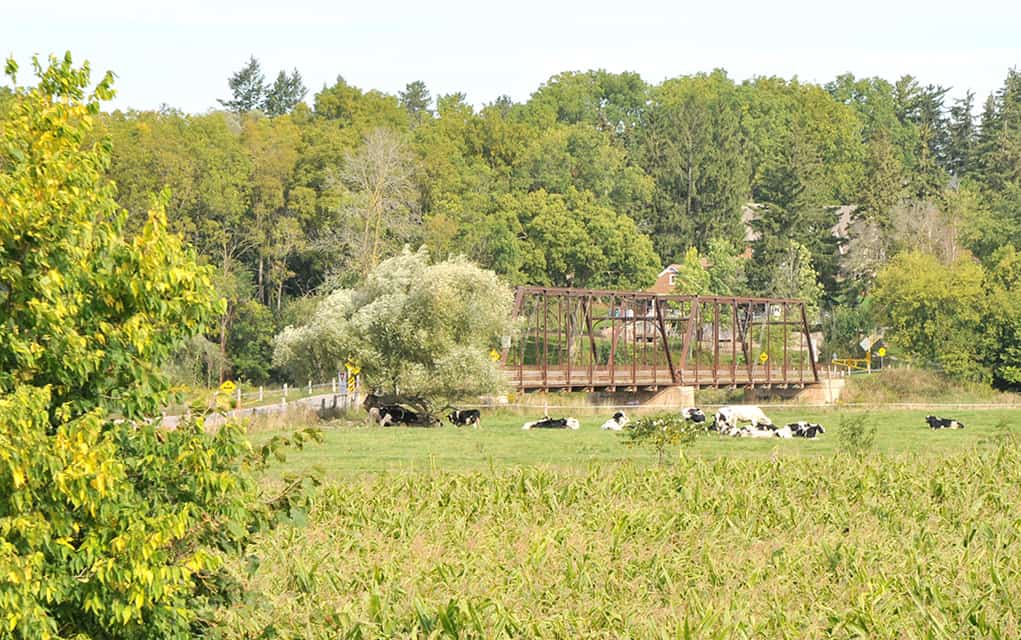The Glasgow Street bridge will carry traffic in just one direction – south – when it’s rehabilitated, a solution that this week got formal approval from Woolwich council.
Getting a big boost in the form of federal and provincial funding, the township plans to spend some $1.3 million in hopes of expanding the bridge’s lifespan by a few more decades.
When the old steel bridge eventually requires another big overhaul, the structure will be closed to all traffic, but maintained for its historic value.
The plan also called for the removal of turning restrictions at the intersection of Glasgow Street and Millennium Boulevard, a boundary road with the City of Waterloo.
After reviewing a range of options in an environmental assessment process launched a couple of years ago, the township and its engineering consultant recommended the approach councillors ultimately adopted.
The federal government will provide about $700,000 for the project, while the province kicks in $470,000. The remaining $235,000 will be covered from township coffers.
Built in 1886, the pratt truss structure is unique in the region. But the structure has been closed and repaired on numerous occasions in the past decade or so, prompting the environmental assessment process that looked at options ranging from demolition to replacement with a new bridge.
“The bridge was never intended to last this long,” he said of the 133-year-old structure, noting the average lifespan of a bridge is about 70 years.” Jack Turner, GM Blueplan
The recommendation to rehabilitate the bridge would maintain the current five-tonne load limit and keep traffic flowing in recognition of the current volumes – about 1,000 cars per day – not found at two other steel bridges earmarked for permanent closure and removal. Rehabilitation costs alone were enough to recommend mothballing steel bridges on Peel Street in Winterbourne and the Middlebrook Road boundary with Centre Wellington Township.
Staff and consultants struggled with a number of issues during the review, Ryan Tucker, an engineering project supervisor with the township who’s been spearheading the bridge studies, told councillors meeting Tuesday night.
For starters the location is “not great” given ongoing erosion and flooding problems. While the bridge was moved to its current spot in 1928, moving it isn’t an option now.
Along with traffic counts, the historic value of the bridge was a key part of discussions to keep it open for as long as possible, he added. But the age of structure presents challenges.
“The bridge was never intended to last this long,” he said of the 133-year-old structure, noting the average lifespan of a bridge is about 70 years.
Converting the single-lane bridge into a simply a southbound crossing over Conestogo River “solves many of the issues,” noted Jack Turner of the engineering firm GM BluePlan.
Along with reducing traffic volumes and encouraging commuters to find alternative routes, a one-way option eliminates waiting as vehicles jockey on the south and north sides to cross the single-lane span. Instead southbound traffic will flow smoothly, with drivers perhaps more inclined to follow the one-vehicle-at-a-time rule if there’s less waiting, he suggested.
But Coun. Murray Martin, who lives in Conestogo, expressed scepticism about the one-way option, noting drivers already disobey current bylaws such as one-at-a-time and the speed limit, not to mention the weight restrictions.
“I think we’re kidding ourselves,” he said.
He also questioned a Region of Waterloo report suggesting rerouting traffic away from the bridge would have a minimal impact on Northfield Drive traffic, noting the intersection at Sawmill Road is already a problem during the evening rush hour.
Tucker, however, said the region sees the current intersection as adequate for another 20 years before it would need a substantial upgrade to handle traffic volumes.
Of more pressing concern will be enforcing rules designed to protect the bridge from heavy loads. The township is already aware of violations, and the one-way rule would be another thing to monitor, he added.
In that vein, Coun. Patrick Merlihan asked if there were any technical measures, such as traffic spikes, that could prevent cars from travelling against the one-way flow. The township has in the past also discussed installing cameras to record violations.
Turner noted the current process looks at planning issues, with detailed engineering that could include such measures to be discussed at a later date.









